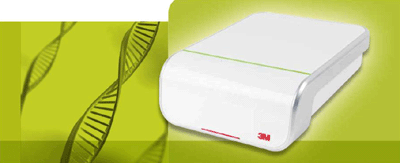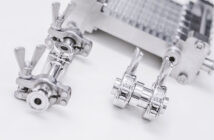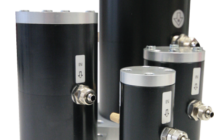3M says its new molecular detection system is a fast, accurate and easy-touse method of detecting dangerous pathogens like Salmonella, E. coli O157 and Listeria, that can shut down businesses and threaten public health.
The 3M molecular detection system is based on a combination of single technologies involving isothermal DNA amplification and bioluminescence
detection. The system was designed with customer testing needs in mind and has resulted in a compact, simple, robust system that offers easy implementation and low maintenance without compromising accuracy and reliability, the company says.
“Leveraging 3M’s record of innovation, including close collaboration with our customers, we believe we’ve found a transformational solution that makes for a faster and simpler way of accurately detecting pathogens,” says vice president and general manager of 3M Food Safety Francine Savage.
“Just as 3M petrifilm plates succeeded by melding sophistication with simplicity, the 3M molecular detection system optimises technicians’ time and productivity, improving bottom lines, protecting brands and ensuring public health.”
Sensitive, uncompromised results in a compact unit
The new system delivers highly sensitive results by targeting and amplifying nucleic acid in enriched samples. The automated technology has been evaluated with a variety of food types including produce, meats, processed foods, pet food and food-processing related environmental samples. The instrument is sleek and compact – taking up less counter space than a laptop computer, making it portable and adaptable to various lab environments.
“Pathogen testing has now been made simple and affordable”, says Food Safety global marketing development manager Niki Montgomery.
“Food processors will benefit greatly from the system’s affordable accuracy and fast time to results, minimising downtime in the lab. Numerous organisms can be tested in a single run and it was designed to help our customers perform fewer repeat tests and make critical decisions faster.”
Three assays available, validation efforts underway
The molecular detection system uses simplified handling steps and reduces the time to result. Each type of assay uses the same software interface and same DNA extraction protocol for testing between one and 96 samples per run. Assays for Salmonella, E. coli O157 (including H7) and Listeria are available immediately, while a test for Listeria monocytogenes is expected early this year. 3M is continuing to develop a full portfolio of pathogen
testing solutions.
Independent laboratory studies with the 3M Molecular Detection System are currently underway to pursue global method recognitions.
“In our evaluation of the Listeria species assay, we liked the small footprint of the system as well as the quick delivery of results after sample enrichment,” says Dr Martin Wiedmann, a professor in Cornell University’s Department of Food Science who studied the system’s analyses of samples taken from meat-packing, seafood processing and retail locations.
“This system definitely illustrates the potential of isothermal methods for rapid detection of foodborne pathogens.”
For more information:
Tel: 0800 808 182
Visit: www.3m.co.nz/foodsafety





























































































